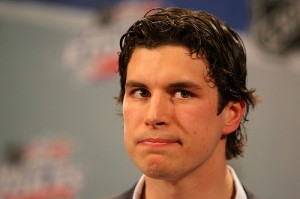One thing was made clear at the Sidney Crosby press conference today: the Pittsburgh Penguins captain has shown symptoms of the most harmful sort of concussion coupled with the longest recovery road.
Crosby appeared today on national broadcasts alongside Penguins general manager Ray Shero, and concussion specialists Michael Collins and Ted Carrick. Collins has been the primary doctor for Sid since January while Carrick was called upon after Sid reached an “80%-90%” recovery level but had regressed due to strain.
On a day when many were fretting about the possibility of Crosby taking a season off or even retiring, the mood in the press room was reassuring. When asked if, given the severity of the concussion, whether retirement was a serious consideration, Sid stood fast: “I wouldn’t bet on that”. What was most reassuring to fans of Crosby and of the sport was that the team assembled behind the microphones appeared on the same page. Sid was well informed with regard to his recovery and all shared an enthusiasm for his eventual return.
No timetable was set.
“Sid’s a Ferrari” said Michael Collins, and evidently is being treated as such. Although he may have reached a 90% recovery stage, all four men ensured those watching and listening that Crosby will not return until his symptoms are non-existent. Collins especially seemed well aware of the microscope that was focusing in on this saga as well as the fact that the hockey world is now ready to trust more in medical science than the sports’ long-held notions of “instinct” and “gut feelings”.

Sidney Crosby’s case is the Ferrari of concussion studies and as the field expands and improves, so too does the sport. If Sid the Kid can fully recover, a ton of credit will heaped upon Collins, Carrick and the field at large. The medical community’s careful and logical approach to a person’s safety is likely one that will be adopted by fans and league management alike as the fate of the sport’s most notable player hangs in the balance. When the game’s best player, at a crossroads in his career, hosts a media field day to show his trust in science, the sporting world will take notice. Nobody wants to lose Sid.
Although nothing was made clear about when he would return, the idea of retirement should now be put to rest. “That’s the last thing I want” was Sid’s response. Collins said he is “supremely confident” that Crosby will not experience long term symptoms. The doctors, the Penguins and Crosby himself are entirely committed to taking the long road to recovery and “making sure the cows are back in the barn”.
Sid did have something to say about removing head shots from the game saying: “there’s no reason not to”.
The next question facing the NHL and its fans is: What kind of game do people want? Do they want to see a Ferrari being chased by a dump truck? A rink full of Ferrari’s with the occasional bumper-car incident? What lies in between these two possibilities?
Whether or not head shots are removed, the speed of the game will result in some terrible accidents. Perhaps the celebrity that Sid brings to this discussion is what will expedite the ideal compromise.
Follow me on Twitter @_Joe_Pack_
“assured” not “ensured,” Joe.
As much as I’ve joked about St. Sid, the fact remains that he is one of those rare prodigies that fans tell their kids about seeing. Anyone who sincerely loves hockey has to want to see him return. However, I’m old enough to remember seeing athletes who were injured who should have aged out of active status struggling to remain. It’s painful and tragic for everyone concerned.
To those who find a season off untenable, think of how it would be to see a struggling Crosby who has not been given a chance to get back to his former self. I’d much rather see Sid the Kid at 100% in 2012/2013.
Kudos to the organisation for not pushing for a return to active status too soon. Crosby’s career and life might not be the only ones that are saved by acquiescing to the medical community’s need to learn all they can.